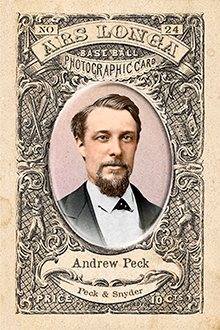
- Series: Pioneer Portraits I: 1850-1874
- City: New York
Andrew Peck (1836-1918) and his partner Walter Irving Snyder founded the first true sporting goods store in 1866 at 124-128 Nassau Street in New York City. The pair wanted to promote their business and thought trade cards might help. In 1869, this was a common technique for many retailers, but Peck and Snyder wanted something distinctive. They came up with the idea of using the image of Harry Wright’s nationally renowned new professional baseball squad, the Cincinnati Red Stockings, as their motif. A few versions were printed, the most prized of which today features the players in uniform and their names below the photo. No one could have known that this modest marketing scheme would pave the way for one of the great products and hobbies in American history, as Peck and Snyder unwittingly established a framework for the mass-produced baseball picture card. Following the Red Stockings release, the company issued cards featuring the hometown Mutuals and rival Chicago White Stockings in 1870. Other manufacturers soon followed suit and baseball cards became an advertising mainstay.
- Peck posted inning-by-inning telegraph reports of the big game between the NY Mutuals and Wright’s club in 1870 to a fevered crowd of NY “cranks.” Final tally: Cincinnati 15, NY 12.
- Peck started his business with ten cents to his name and died a rich man
- Perhaps not rich enough to buy his own trade cards today though: a Peck & Snyder 1869 Cincinnati Red Stockings card recently sold for $75,000

- Series: Pioneer Portraits I: 1850-1874
- City: Baltimore
- Team: Canaries
- League: National Association (NAPBBP)
Lipman Emanuel Pike (1845-1893) has many claims to fame as one of the most prodigious power hitters of early baseball. He was one of the first to be paid to play, he was a perennial field general on some of the best teams of his era, he hit some of the longest home runs in the earliest parks, he was one of the first players blacklisted, he was one of the fastest players of his time. And, if not the first, he was certainly the first Jewish player of note in the game. Pike came up in the infancy of baseball and starred for the great early clubs: The Brooklyn Atlantics, Philadelphia Athletics, NY Mutuals and the Irvington NJ nine. A solid all-around player, the southpaw even held his own at second and short. Movie-idol handsome, Lip always made his team look good. And he made a lot of teams look good. A lifelong itchy foot led Pike to change clubs as often as some players changed spikes. He never lasted more than two seasons with any franchise. In an era when home runs were scarce, Lip was one of the top sluggers. In 1883 Sporting Life documented a remarkable artifact of Pike's power. With the demolition of Brooklyn's old Union Grounds, the writer described the “pagoda” that had stood in right center from which rose an iron rod, bent from a ball struck by Pike and preserved as a cherished icon. Later research indicates Pike's HR slammed that rod 40 feet above the ground and about 360 feet from home plate hard enough to bend iron - in the deadball era.
- Pike, with eight others, was ousted by the NL owners in 1881 for suspicion of throwing games
- Out of the game, Pike returned to his family haberdashery in NY where he perished from heart disease at age 48. His renown persisted for decades, leading to one vote in the first HOF ballot in 1936

